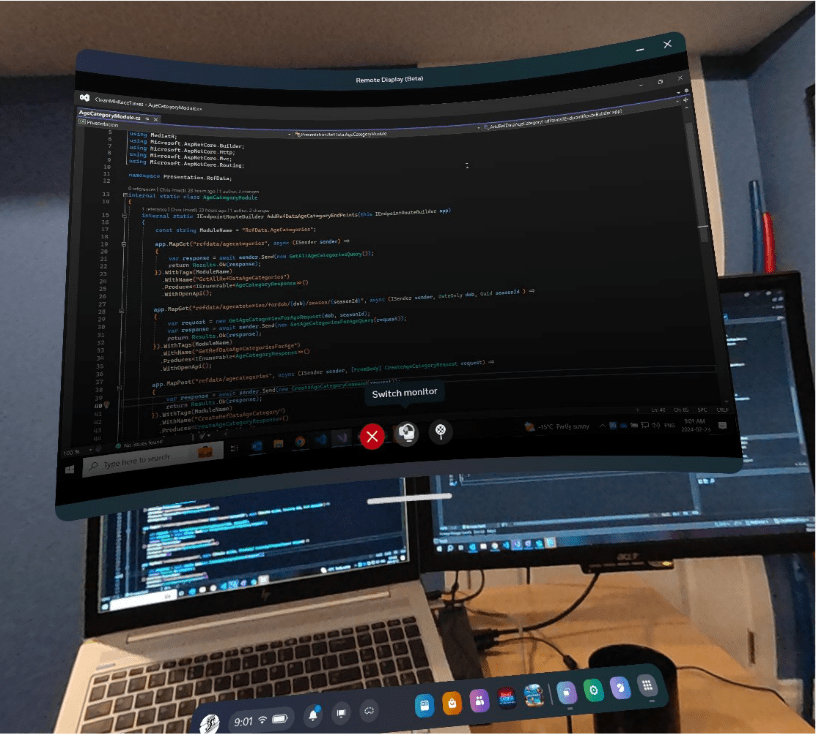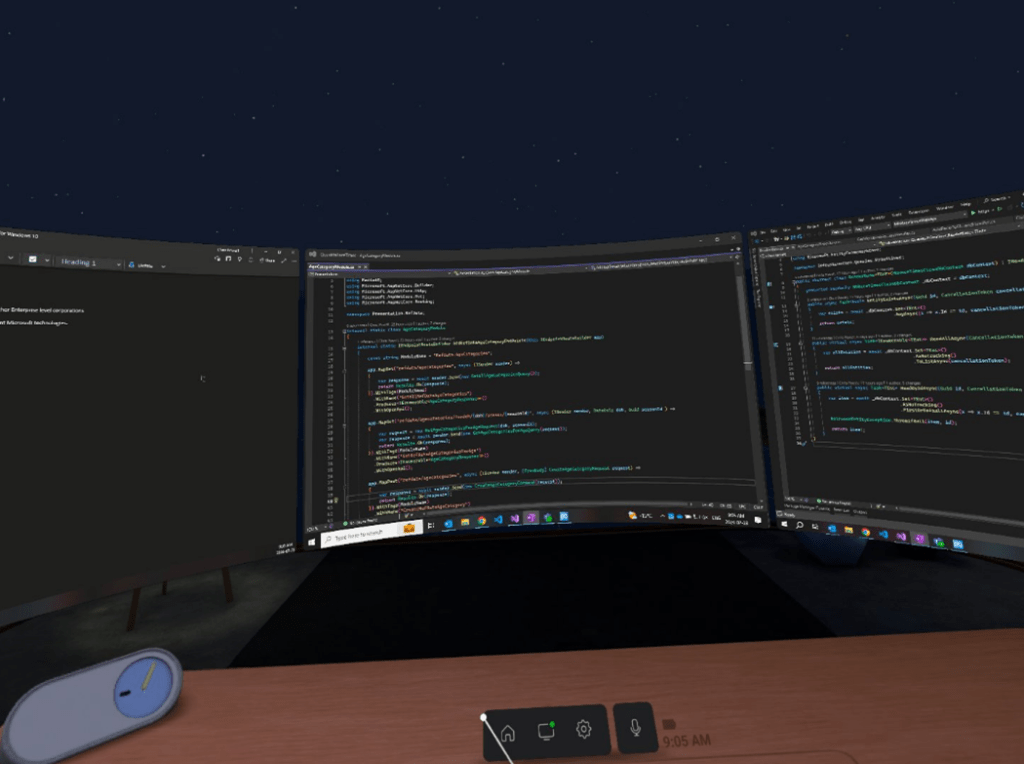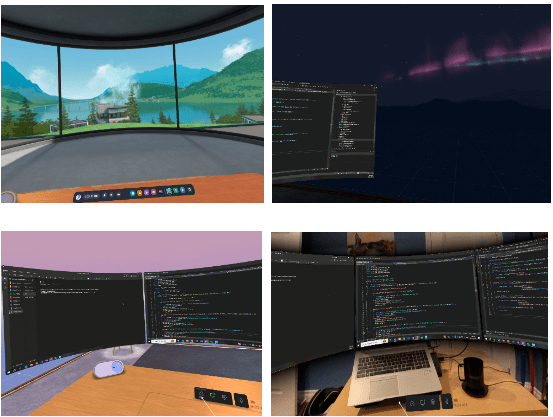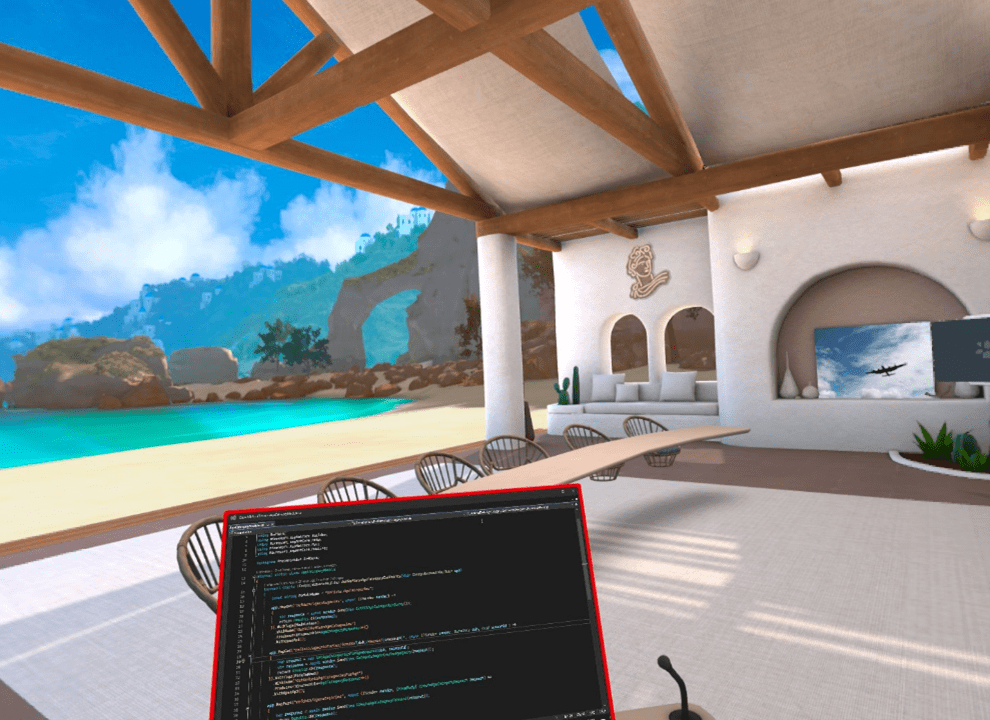
Virtual Workspaces Are Here! How Will You Use Them?
April 4, 2024
My YouTube feed has been full of reviews of the Apple Vision Pro since it became available in the US on February 2. In one of the videos, the content creator used the Vision Pro for working on his script, and several other tasks around his house (See video). This intrigued me and I wondered what it would be like to code in a virtual environment and create virtual workspaces. I don’t have $4k lying around and the Vision Pro isn’t available in Canada yet. So, my ability to try it was rather limited.
For Christmas 2023, I bought myself a Meta Quest 3 headset. Thanks in part to our Christmas present from Imaginet (Thanks Rod!). I wondered if I could find a way to use the Quest 3 for coding. There are quite a few different apps on the Meta store that offer virtual meeting spaces. However, I decided to use the Meta developed offerings, figuring they’d get the best use out of the headset – and they were free.
The first app I tried was the “Remote Display (Beta)” app. As the name suggests, this is still in the beta stage. To get the headset to communicate with your laptop, you have to install the “Meta Quest Remote Desktop” app on your computer. Your computer will need to be on the same network as the WIFI your headset is connected to. Installation of the remote desktop app doesn’t take long. Then you have to get the “Remote Display (Beta)” app installed on your headset from the Meta store. Run the “Remote Display (Beta)” app on your headset and you should now be able to communicate with your laptop.
The Remote Display app only shows you a single monitor from your computer. If your computer has multiple monitors, you can switch between them, but you can only see one at a time. There is only passthrough mode with this app. You get a larger view of your computer monitors, but that’s it. It’s functional, but not being able to see multiple monitors at once limits its utility.

The next app I found is “Meta Horizons Workrooms (Beta)”. This uses the same “Meta Quest Remote Desktop” ” app on your computer to communicate with your headset. “Meta Horizons Workrooms” has a bit more utility than the “Remote Display” app.

When you open the application in the headset, you will immediately be presented with any monitors that are connected to your computer (up to 3). If your computer only has two physical monitors, you can add a third “virtual” monitor, and move windows on to it. My computer only has two monitors, and I was able to work with 3.
Seeing that working with Meta Workrooms was going to be much more realistic than Remote Display, I decided to dogfood it for a couple days. For 3 days I worked in Meta Workrooms, coding with Visual Studio 2022. Here is what I noticed while using Workrooms for 3 days:
Working in the Workrooms office was like working in a regular office. There are several different offices you can work in: Cabin, Dark, and Bright. There is also Passthrough mode, where you just get the screens and see your current physical office. This is handy if you need to talk to someone in real life. Switching between the different offices is painless. If you want to switch up the environment, it’s simply a quick selection. An option you have in virtual workspaces but not in an actual office space.

The virtual desk in the office has a passthrough mode as well, so you can see the desk immediately in front of you. This is helpful if you lose track of where your mouse is. It also has a “Whiteboard”, which is somewhat less useful. To use it, you hold the Quest Controller like a pen, with the handle down.

The whiteboard “stylus” is hard to use and has trouble registering when you want to write. You can make sticky notes, but you can’t put them anywhere else on the desk. They have to stay on the whiteboard. You can’t see the whiteboard and your desktop at the same time, so if you want to see your keyboard, you can’t see your sticky notes (and vice versa). Limitations in virtual workspaces are to be expected.
Something I was unable to dogfood was the Meeting Rooms. Workrooms can host meetings with multiple attendees. These are hosted in meeting rooms. There is a white board and a large screen for sharing a single computer monitor. The meeting room is configurable for multiple types of meetings, from presentations to collaborative efforts. And there are several different environments to host the meeting room. From beach terraces, cabin views, to city office spaces, they have quite the selection.

The meeting rooms look very functional, and it would be interesting to try it out for a remote meeting instead of Zoom or Teams. The ability to look around and see people/avatars promises to raise engagement. You just need all your co-workers to have a Quest 3 headset…
Working with the headset for multiple hours is going to challenge your head and the battery of the headset. I found that playing games on the headset for an hour or so was fine. Beat Sabre is fun and much different than any other game I’ve played. But wearing the headset for 3+ hours is more difficult. The head strap that comes with the headset works but isn’t comfortable for extended use. There are a couple pressure points that eventually make themselves known. Spending some time adjusting the head strap so it sits on your head nicely will extend the time you can use the headset in one sitting, but it won’t fix it entirely. There are after-market head straps for the Quest 3, but I did not have the opportunity to investigate or test any of them.
The battery of the Quest 3 is limited to an hour or two. To get more continuous use out of it, I had to jerry rig a setup to allow the headset to be plugged in and keep the cords out of my way. If you get an after-market head strap, you can get ones with a battery pack built into it. Depending on the battery pack, that could extend your use time to 3 or 4 hours. But that still isn’t a full workday.
Ultimately, I was only able to use the Quest 3 for about 3 hours of work per day. The combination of the weight on my head, pressure on my face, and the eye strain that eventually built up meant 3 hours was about as much as I could do. I really enjoyed working in the Workrooms office. The limitations weren’t in the app, but in the headset itself. Once the form factor is reduced in size to something closer to regular eyeglasses, virtual workspaces will be a legitimate option for working and meeting.
Update:
After the initial pass at this article, I decided to get myself an aftermarket head strap for the Quest 3. It made a world of difference. The new head strap does a much better job at balancing the quest on your face and it doesn’t dig into the back of your head. Wearing the Quest 3 now doesn’t feel like it’s pulling your head forward, and thus doesn’t press on your face quite as much. The new head strap also has a built-in battery pack. Using the battery pack extends the length of time I was able to use the headset before having to plug in. It roughly doubled the time I was able to remain in these virtual workspaces. The plug for the headset battery pack is on the back of the unit, and you can plug it into power while wearing the headset. The location of the plug makes wearing the unit while charging much better.
Eye strain is still an issue over a longer period of time. I wear glasses for distance, and now progressives for close in. I have to wear glasses while using the headset, or I can’t see things clearly. I’m able to fit an old pair of non-progressive glasses into the Quest 3, and that has been working for me. I do notice there’s a glare off the glasses when viewing a bright screen or game. I’m not sure if the glare affects my eyes, or if the glasses don’t sit quite right when in the headset, but I get eye strain after a couple hours. There are prescription lenses you can buy for the Quest 3 that clip directly onto the headset. That would eliminate the need for glasses. The advertisements I’ve seen for them are only $70, so it might be worth a try to be able to remain in the virtual workspaces longer.
I have also found that using the hand gestures to use the Workrooms interface gets easier over time. It just takes some practice to get used to it. You need to make sure when you “pinch” your fingers to do the equivalent of a mouse click, your thumb and index finger need to be visible to the Quest 3’s cameras. Having your thumb out of sight won’t register clicks and can be frustrating.
Thank you for reading! At Imaginet we are always staying on top of the latest technology trends. If you have a project in mind, fill out the form at the bottom of the page and someone will be in touch. Make sure to follow our blog so you don’t miss out on our technology tips, tricks, and updates.

Discover More
What to Know About Microsoft’s New OneDrive Archiving Policy
Earlier this year, Microsoft announced it was rolling out a significant change to how it handles unlicensed OneDrive user accounts. Microsoft’s new OneDrive archiving policy is something every IT admin…
Slaying the Dragon: Tips for Legacy Application Modernization
Many organizations have them: old applications written in time immemorial, poorly documented, and with nonexistent tests. Yet, they’re still responsible for holding up key parts of the production environment, even…
The Myths of the Low Code/No Code Solutions
The Power Platform solutions that include Power Apps, Power Pages, and Power Automate, offer low code/no code solutions for application builds. This is fantastic when you have quick and simple…

Let’s build something amazing together
From concept to handoff, we’d love to learn more about what you are working on.
Send us a message below or call us at 1-800-989-6022.




